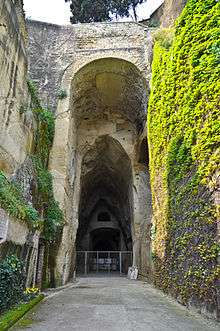Virgil's tomb
Virgil's tomb (Italian: Tomba di Virgilio) is a Roman burial vault in Naples, said to be the tomb of the poet Virgil (October 15, 70 BC – September 21, 19 BC). It is located at the entrance to the old Roman tunnel known as the Crypta Neapolitana or grotta vecchia in the Piedigrotta district of the city, between Mergellina and Fuorigrotta.

History
Virgil was the object of literary admiration and veneration before his death. In the following centuries and particularly in the Middle Ages his name became associated with legends of miraculous powers and his tomb the object of pilgrimages and pagan veneration.[1]
At the time of Virgil's death, a large bay tree was near the entrance. According to a local legend, it died when Dante died, and Petrarch planted a new one; because visitors took branches as souvenirs the second tree died as well.[2]
Virgil's death
When Virgil died at Brindisi in 19 BCE, he asked that his ashes be taken back to his villa just outside Naples. There a shrine was created for him, and sacred rites were held every year on his birthday. He was given the rites of a hero, at whose tomb the devout may find protection and counsel. Virgil's tomb became a place of pilgrimage for many centuries, with Petrarch and Boccaccio being among those who visited the tomb.
Presently, the tomb serves as a tourist attraction, and still contains a tripod burner originally dedicated to Apollo. There are no human remains in the tomb, however, as Virgil's ashes were lost while being moved during the Middle Ages.[3]
References
- Ziolkowski, Jan M.; Putnam, Michael C. J. (2008). The Virgilian Tradition: The First Fifteen Hundred Years. Yale University Press. pp. xxxiv–xxxv. ISBN 0300108222. Retrieved November 11, 2013.
- The Tomb Of Virgil Old and Sold
- Oggetto Artistico : Virgil's Tomb Archived 2012-04-02 at the Wayback Machine Parco della Tomba di Virgilio. Circuito informativo regionale della Campania per i Beni Culturali e Paesaggistici.